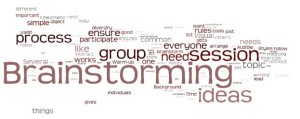The First in a Series of DIY Consulting Tools We’ll be Sharing Every Other Tuesday!
 Brainstorming is a tool you can use to list as many ideas as possible in a short period of time. Teams often use it because it encourages active participation from all team members. This tool will help a team think about and list all dimensions of a problem or solution.
Brainstorming is a tool you can use to list as many ideas as possible in a short period of time. Teams often use it because it encourages active participation from all team members. This tool will help a team think about and list all dimensions of a problem or solution.
You can use a structured approach to brainstorming where all team members are asked in turn to suggest an idea, or you can use an unstructured approach, where members offer ideas randomly as they come to mind. We at Najera Consulting prefer an unstructured approach.
To Use The Brainstorming Tool:
- Agree with team members how long the brainstorming session will be. Ten or fifteen minutes are usually adequate. Assign a “timekeeper” to keep track of the time.
- Remind team members of the rules for brainstorming: never criticize an idea; write down every idea offered; and do things quickly to keep the energy flowing. Encourage building on others’ ideas; encourage “off-the-wall” thinking. Post the rules where team members can see them.
- Decide whether to use a structured or unstructured approach. If you choose a structured approach, decide who will go first. Allow team members to “pass” if they don’t have an idea when their turn comes.
- Assign a “scribe” who will write down the ideas on a flip chart or white board as they are given. Sometimes two scribes are necessary.
- Have fun! Remember, even silly ideas can cause someone else to think of a useful idea.
Use this tool when:
- Many ideas are requested/required to address a problem or a solution.
- Any mixed/varied groups are gathering to formulate ideas.
- Facilitating a problem-solving session.
- Creativity is required to solve a problem.
To Learn More:
We recommend the following two books for those of you interested in learning more.
- The Team Handbook Third Edition by Peter R. Scholtes, Brian L. Joiner, and Barbara J. Streibel.
- Big Book of Brainstorming Games: Quick, Effective Activities that Encourage Out-of-the-Box Thinking, Improve, Collaboration, and Spark Great Ideas! by Mary Scannell and
Remember, when you’re generating ideas, seek quantity first. You can think about the quality of the ideas later. Never criticize an idea when it is given; dong so tends to intimidate other members from offering their ideas. Write down every idea and do it quickly so that the team’s energy and enthusiasm isn’t lost.
 You can use an alternative to the standard brainstorming techniques using Post-ItTM Notes. In this format, group members spend five or ten minutes of “quiet time” writing down ideas on 3 x 5 Post-ItTM Notes. Then each member in turn places one idea on a board then briefly explains it. Others are encouraged to build on that idea or add their own similar ideas before proceeding to the next member. The group should discuss and categorize ideas at this point, but they should not eliminate any ideas yet. Once all members have contributed their ideas, the group evaluates them and arranges them by priority.
You can use an alternative to the standard brainstorming techniques using Post-ItTM Notes. In this format, group members spend five or ten minutes of “quiet time” writing down ideas on 3 x 5 Post-ItTM Notes. Then each member in turn places one idea on a board then briefly explains it. Others are encouraged to build on that idea or add their own similar ideas before proceeding to the next member. The group should discuss and categorize ideas at this point, but they should not eliminate any ideas yet. Once all members have contributed their ideas, the group evaluates them and arranges them by priority.











I am so glad to find this article. I love to use brainstorming in my job and had seen a similar set of guidelines for effective brainstorming, but I couldn’t find it when I needed it. I love this list and I’m going to put it right to work. Thank you! Thank you! I especially like the time limit idea to keep the energy flowing! Too many times the brainstorm sessions just peter out and that drains the enthusiasm.
Great stuff… Brainstorming is a terrific tool and you give some wonderful advice on how to do it better. I look forward to next Tuesday for more help.
I rather enjoyed this post. Truly one of the most vital enterprises in which we can engage is that of brainstorming. Few worthwhile endeavors have come to fruition as the result of a single person’s thinking. While we often credit innovations to a single individual, a closer look reveals that many minds– and the efforts of more than the one were at work. Edison had an entire team of people working on all of “his” inventions…many of which may have originally come from the idea first presented by others. Your list of guidelines seems right on target!
I think brainstorming is one of the least utilized tools in every realm, whether it be for personal problems or work related business. We were taught how to brainstorm but never the actual applications of it in school. It was something you did with others on a project, but not something you applied in the real world. I think brainstorming definitely needs to be used more often.